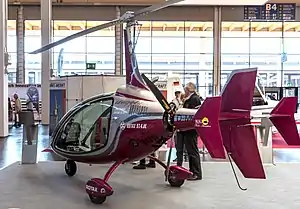Niki Lightning
The Niki Lightning is a fully enclosed two-seater tricycle autogyro of composite construction, designed and built by Niki Rotor Aviation in Bulgaria. It was introduced in 2009[1][2]
| Lightning | |
|---|---|
 | |
| Role | Autogyro |
| National origin | Bulgaria |
| Manufacturer | Niki Rotor Aviation |
| Introduction | 2009 |
| Status | In production (assembled, 2017) |
| Produced | 2009-present |
| Variants | Niki Kallithea |
Design and development
The Lightning's cockpit pod accommodates a pilot and passenger in tandem. The main rotor is two-bladed, with a pre-rotator. Unconventionally the tail boom is mounted though the centre of the propeller shaft.[3] The boom may be unbolted and removed to aid access to the engine and prop.
There is a choice of two very compact D-Motor engines (both liquid-cooled horizontally-opposed side-valve four-strokes): either the 95 hp (71 kW) 4-cylinder LF26 or the 130 hp (97 kW) 6-cylinder LF39. The engine is sited behind the cockpit, driving a 3- or 4-bladed ground-adjustable pusher propeller which is coaxial with the tail boom. The D-Motor engines are direct-drive units redlined at 3,000 rpm. The engines are sited beneath the thrust line of the propeller; instead of using a gearbox, the Lightning uses a multi-belt-drive reduction system of about 3:2 ratio, resulting in an efficient propeller speed of up to 2,000 rpm.[4] This arrangement avoids the necessity of a tailboom beneath the propeller, giving a smoother empenage and reducing drag. Beneath the tail-fin a spring-steel tailskid is fitted, to inhibit propeller strikes.
Consuming some 15 l (4.0 US gal; 3.3 imp gal) of avgas per hour, the autogyro has an endurance of 4 hours, with 30 minutes reserve. Its cruise speed of 81 kn (150 km/h; 93 mph) gives the autogyro a range of over 320 nmi (590 km; 370 mi). It has a take-off roll of 70 m (230 ft), and a landing roll of 20 m (66 ft).[2] The Lightning may be flown with its side doors removed.[5]
An alternative engine for the Niki Lightning is the Rotax 914UL (but the normal Rotax gearbox would be dispensed with in favour of the drive belts).[6]
Specifications (D-Motor LF39)
Data from US distributor[2]
General characteristics
- Length: 4.55 m (14 ft 11 in)
- Height: 2.85 m (9 ft 4 in)
- Empty weight: 265 kg (584 lb)
- Max takeoff weight: 560 kg (1,235 lb)
- Fuel capacity: 70 l (18 US gal; 15 imp gal)
- Powerplant: 1 × D-Motor LF39 6-cyl horizontally opposed, liquid-cooled, piston engine, 97 kW (130 hp)
- Main rotor diameter: 8.5 m (27 ft 11 in)
- Propellers: 4-bladed, 1.75 m (5 ft 9 in) diameter
Performance
- Maximum speed: 170 km/h (110 mph, 92 kn)
- Cruise speed: 150 km/h (93 mph, 81 kn)
- Minimum speed 35 km/h (19 kn; 22 mph)
- Endurance: 4h with 30 min reserve
- Service ceiling: 3,000 m (9,800 ft)
- Rate of climb: 5 m/s (980 ft/min)
References
- "Welcome - Helicopters International, LLC". lightningautogyro.com. Retrieved 28 February 2016.
- "Lightning Autogyro - Helicopters International, LLC". lightningautogyro.com. Retrieved 28 February 2016.
- Tacke, Willi; Marino Boric; et al: World Directory of Light Aviation 2015-16, page 196. Flying Pages Europe SARL, 2015. ISSN 1368-485X
- D-Motor website
- "Technical Specifications". nikiaviation.com. Retrieved 1 March 2016.
If you prefer more dynamic flight experience you can just remove the composite doors and enjoy the open air cabin.
- Niki Aviation spec sheet